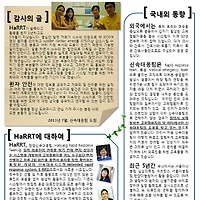한양대학교병원 신속대응팀의 지난 1년간의 성과를 바탕으로 쓴 논문이 SCI 에 게재되었습니다.
2011년 12월 19일 처음 시작한 한양신속대응팀은 약 1년만에 병동내 예측치 못한 사망률을 31% 낮추었고 전체 입원환자의 사망률도 11% 낮춘 바 있으며, 이러한 시스템의 보급이 필요성에 대해 작성한 논문이 Journal of Korean Medical Science에 2014.03월 게재되었습니다.
최근 환자 안전에 대한 관심이 증가됨에 따라 1000병상 이내의 여러 병원들에서도 파견 근무 등을 통해 시스템을 벤치마킹하고자 하는 문의도 종종 받고 있습니다.
환자 안전을 위해 신속 대응 시스템이 다른 여러 병원에서도 널리 도입되기를 바라며, 더욱 열심히 달리는 HaRRT가 되겠습니다.
Abstract: The rapid response system (RRS) is an innovative system designed for in-hospital, at-risk patients but underutilization of the RRS generally results in unexpected cardiopulmonary arrests. We implemented an extended RRS (E-RRS) that was triggered by actively screening at-risk patients prior to calls from primary medical attendants. These patients were identified from laboratory data, emergency consults, and step-down units. A four-member rapid response team was assembled that included an ICU staff, and the team visited the patients more than twice per day for evaluation, triage, and treatment of the patients with evidence of acute physiological decline. The goal was to provide this treatment before the team received a call from the patient's primary physician. We sought to describe the effectiveness of the E-RRS at preventing sudden and unexpected arrests and in-hospital mortality. Over the 1-yr intervention period, 2,722 patients were screened by the E-RRS program from 28,661 admissions. There were a total of 1,996 E-RRS activations of simple consultations for invasive procedures. After E-RRS implementation, the mean hospital code rate decreased by 31.1% and the mean in-hospital mortality rate was reduced by 15.3%. In conclusion, the implementation of E-RRS is associated with a reduction in the in-hospital code and mortality rates.
2011년 12월 19일 처음 시작한 한양신속대응팀은 약 1년만에 병동내 예측치 못한 사망률을 31% 낮추었고 전체 입원환자의 사망률도 11% 낮춘 바 있으며, 이러한 시스템의 보급이 필요성에 대해 작성한 논문이 Journal of Korean Medical Science에 2014.03월 게재되었습니다.
최근 환자 안전에 대한 관심이 증가됨에 따라 1000병상 이내의 여러 병원들에서도 파견 근무 등을 통해 시스템을 벤치마킹하고자 하는 문의도 종종 받고 있습니다.
환자 안전을 위해 신속 대응 시스템이 다른 여러 병원에서도 널리 도입되기를 바라며, 더욱 열심히 달리는 HaRRT가 되겠습니다.
|
|
The Extended Rapid Response System: 1-Year Experience in a University Hospital |
Keywords: Rapid Response System, Implementation, Extended RRS, At-Risk Patient, Death, Sudden, Cardiac, Mortality.
http://www.jkms.org/DOIx.php?id=10.3346/jkms.2014.29.3.423
http://synapse.koreamed.org/DOIx.php?id=10.3346/jkms.2014.29.3.423
'달려달려~ > 왕십리 라이프' 카테고리의 다른 글
| HaRRT 소식지 - 파랑새가 전해주는 편지 Vol.1 (0) | 2013.07.11 |
|---|---|
| 2013.04.11 간호국 이취임식 (0) | 2013.04.11 |
| 2013.04.10 HaRRT Conference - Home vent. & 기침 유발기 (0) | 2013.04.10 |
| 2013.04.03 HaRRT Conference - Hiflow O2 therapy (Optiflow) (0) | 2013.04.03 |
| 2013.03.27 간호학과 총회 (0) | 2013.03.27 |




